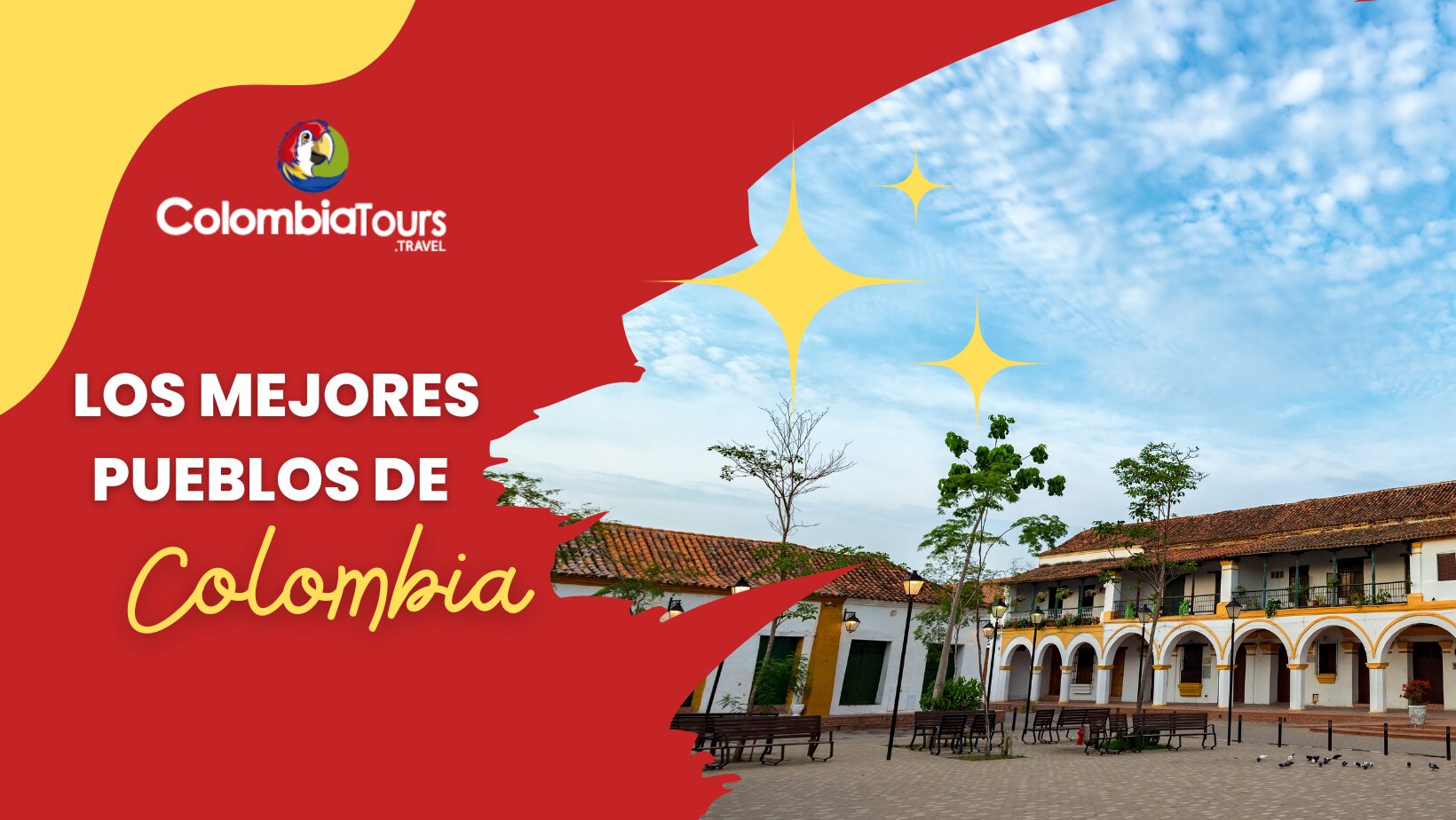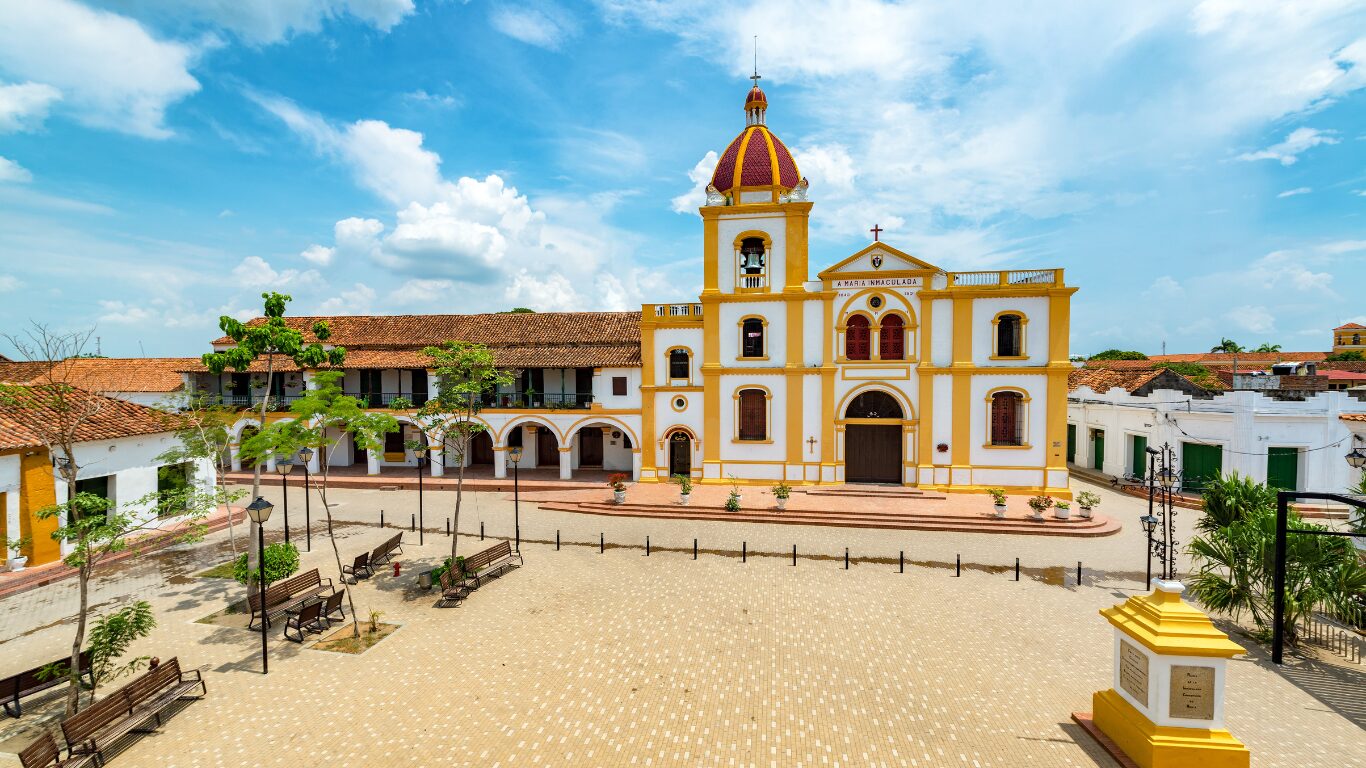
Colombia, a vibrant and diverse country in the heart of South America, is home to some of the most breathtaking landscapes, a rich history, and a culture that can be felt in every cobblestone street of its towns.
These towns, many of which are recognized as heritage villages, represent the soul of the nation, telling stories of struggle, independence, and a cultural fusion that invites tourists from all over the world to discover them.
From colonial architecture to natural wonders, including local crafts and the influence of figures like Gabriel García Márquez, Colombia offers a variety of destinations that capture the essence of its people and the unmatched beauty of its landscapes.
In this blog, we will explore the most beautiful and charming towns in Colombia, highlighting specific must-visit spots within each municipality and offering an essential guide for those who wish to immerse themselves in the true charm of the country
1. Villa de Leyva, Boyacá: Un Viaje en el Tiempo
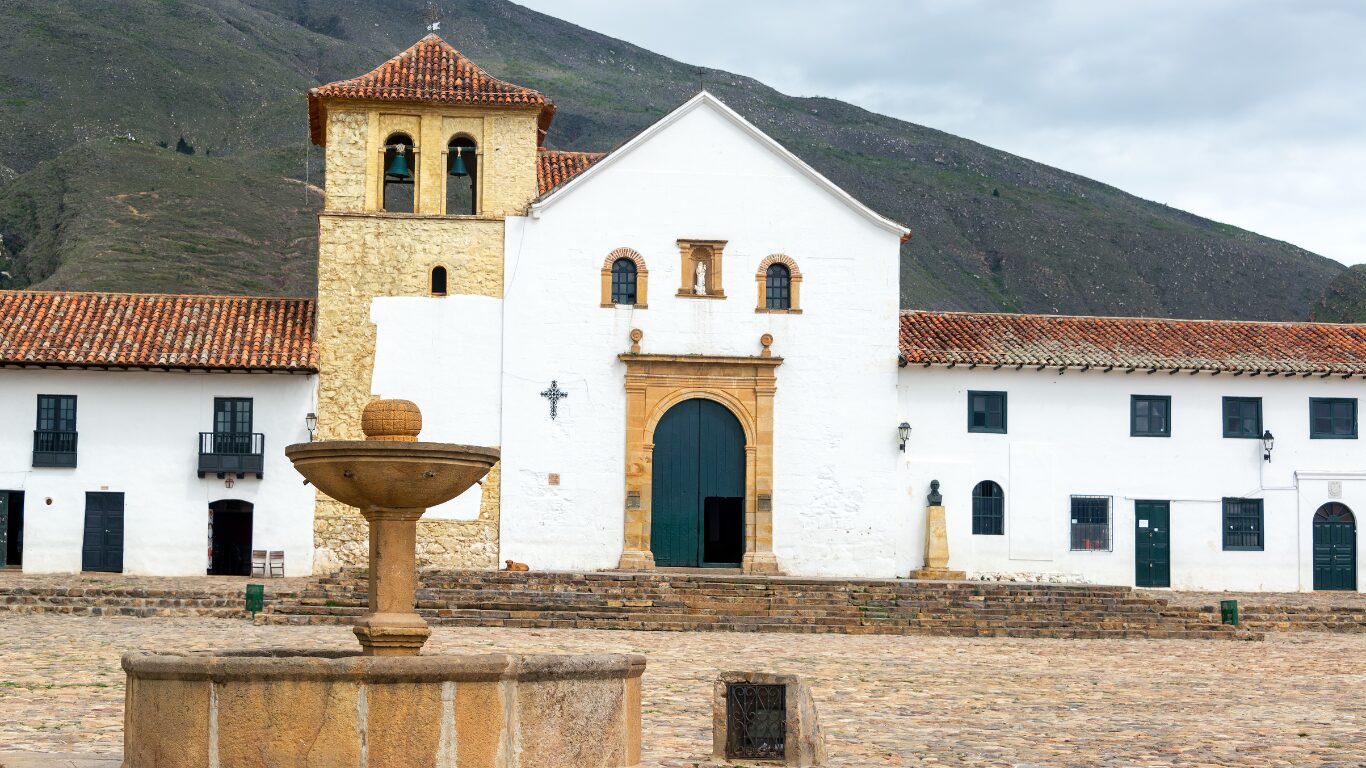
Villa de Leyva is not only a national monument for its meticulously preserved old town, but also a place that feels frozen in time. Its cobblestone streets and the majestic Plaza Mayor—one of the largest stone squares in the Americas—invite tourists to explore every corner of this heritage town.
Places to visit in Villa de Leyva
Villa de Leyva is not only a national monument due to its meticulously preserved old town, but also a place that seems frozen in time. Its cobblestone streets and the majestic Plaza Mayor—one of the largest stone squares in the Americas—invite tourists to explore every corner of this heritage town.
La Periquera Waterfalls: This natural destination is located 15 km from Villa de Leyva and offers an ecological trail featuring three waterfalls, each up to 23 meters high. It’s an ideal spot to reconnect with nature, go hiking along its paths, practice extreme sports, or simply enjoy the beauty of the surroundings.
Paleontological Museum of Villa de Leyva: A scientific space dedicated to the conservation and research of Colombia’s paleontological heritage. Located on the road to Arcabuco, it houses a wide range of fossil collections—from stones to dinosaurs—and stands as a center for learning about the efficient use of natural resources.
Monquirá Archaeological Park (El Infiernito): This site is known for being an astronomical complex of the pre-Columbian Muisca culture, with stone columns that were used to determine the seasons and guide agricultural activities. Located 6 km from Villa de Leyva, it is one of the most important indigenous archaeological remains in the region, offering a window into the practices and beliefs of the Muisca people.
ChatGPT Plus
Chocolate Museum: This unique museum in the city is dedicated to exploring the history, production process, and uses of Colombian cacao. Located in the historic center, it combines delicious chocolate desserts with exhibits that recall the beliefs of ancient indigenous tribes.
Ostrich Farm: Just 6 km from the town center, this place offers the opportunity to learn about ostrich breeding and their life cycle, as well as interact with other animals. Its facilities, inspired by the African continent, include a restaurant, gift shop, and a coffee station.
In addition to these standout spots, Villa de Leyva offers a wide variety of cultural and natural sites to explore from its historic plazas and museums to its breathtaking natural views and outdoor adventures. Each of these destinations contributes to the rich tapestry of experiences that make Villa de Leyva a memorable place to visit.
2. Guatapé, Antioquia: Color and Water
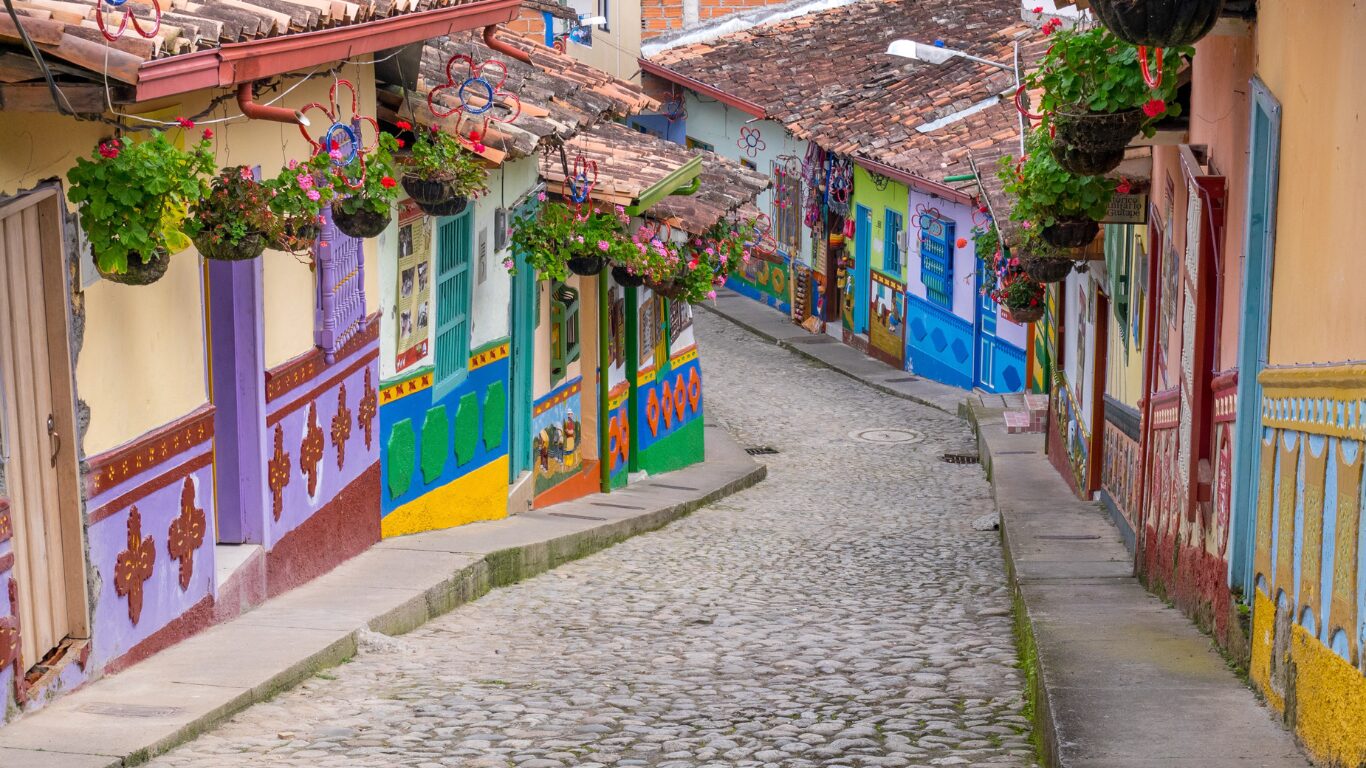
ChatGPT Plus
Guatapé is famous for the Piedra del Peñol, a gigantic monolith that visitors can climb via a staircase to enjoy a panoramic view of the reservoir. The streets and houses of Guatapé are adorned with baseboards (zócalos) that tell stories and bring the town to life with an explosion of color.
Places to visit in Guatapé
Guatapé, known for its reservoir and the colorful baseboards (zócalos) that decorate its buildings, offers a vibrant mix of history, culture, and natural adventure, making it a unique tourist destination in Colombia.
Plazoleta de los Zócalos: This square, located near the main plaza, stands out for its vibrant colors and is surrounded by handicraft shops and restaurants. It’s the perfect place to appreciate local art and enjoy Guatapé’s cuisine.
La Piedra del Peñol: This iconic monolith offers panoramic views of the reservoir and the surrounding region from its summit, which is accessible after climbing more than 700 steps. The history of La Piedra del Peñol, its cultural significance, and the breathtaking view from the top make the climb well worth it.
Calle de los Recuerdos: This steep street is filled with colorful houses and striking baseboards, offering a picturesque walk that replicates a street from the old town of El Peñol, which was submerged during the creation of the reservoir.
Comfama Guatapé Park: It offers a variety of activities for the whole family, including water sports, swimming pools, and play areas. The park also features spaces for relaxation and artistic workshops, making it a versatile place for both entertainment and rest.
Réplica Viejo Peñol: Es una reconstrucción detallada de la antigua aldea de Peñol, ofreciendo una visión fascinante del pasado. Los visitantes pueden explorar sus calles empedradas, admirar las casas de estilo colonial, y aprender sobre oficios tradicionales a través de demostraciones de artesanos locales.
Explore the town at night: Guatapé’s atmosphere completely transforms after sunset. Strolling through its alleys lets you feel the essence of the town and enjoy local life, with a wide variety of local and international restaurants to choose from.
Wake up to a view of La Piedra del Peñol: The Guatapé experience isn’t complete without waking up to views of the monolith. Staying in hotels with views of La Piedra del Peñol can be a magical experience, especially in accommodations that offer romantic getaways and water activities.
Additionally, Guatapé invites visitors to take boat rides on the reservoir, stroll along the boardwalk filled with restaurants and craft shops, or try the zipline for adrenaline seekers. The reservoir, surrounded by small islands, along with water activities like fishing or renting jet skis, completes the experience of visiting this vibrant town.
Each of these places and activities offers a unique perspective on the rich culture, history, and natural beauty of Guatapé, making this destination one of the most memorable to explore in Colombia.
3. Barichara, Santander: One of the Most Beautiful Towns in Colombia
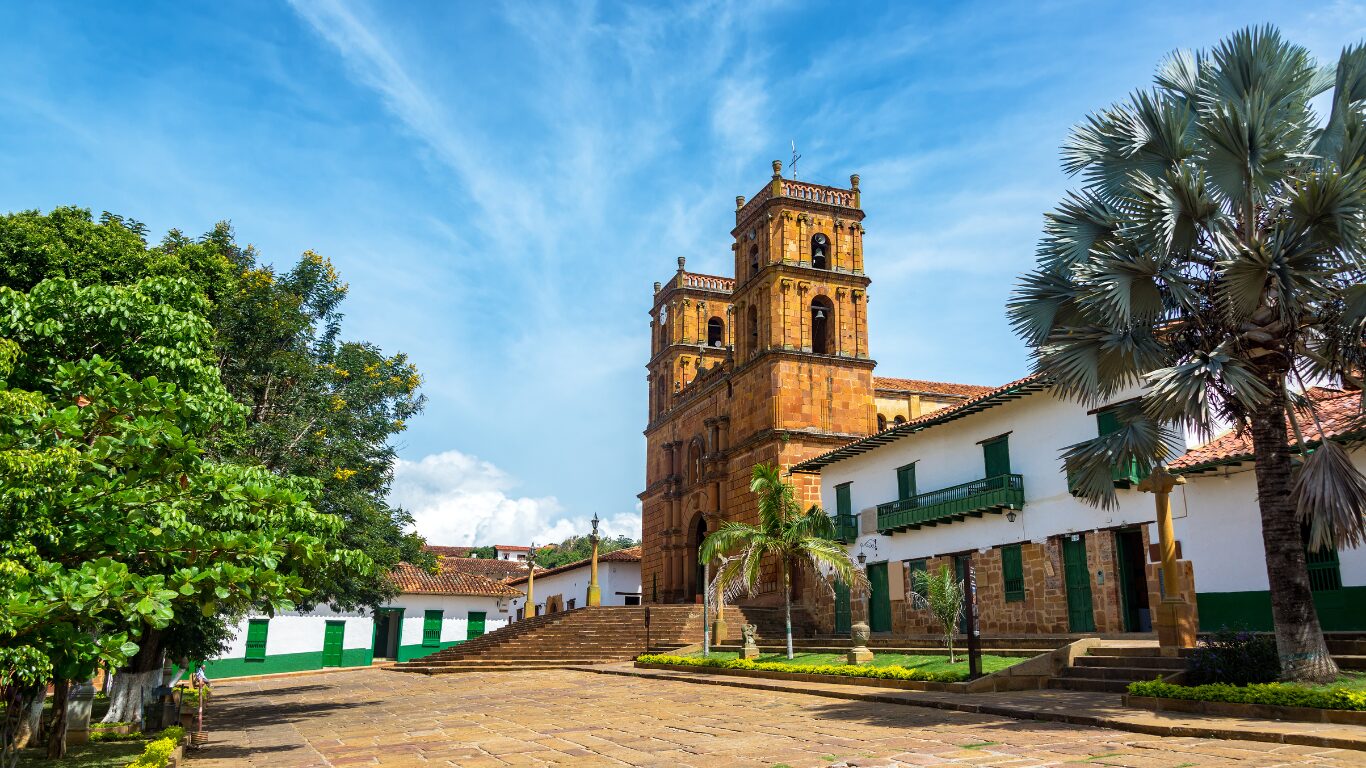
Barichara is known for its well-preserved architecture, with clay and stone houses that highlight the beauty of its old town. Named a World Heritage site, it is a town that feels like a canvas painted with calm and tranquility.
Places to visit in Barichara
ChatGPT Plus
Barichara, known as the most beautiful town in Colombia, is a must-visit destination for those seeking architectural beauty, history, and exceptional cuisine. This charming town offers a variety of activities and places to explore, from its colonial architecture to its natural landscapes.
Salto del Mico: This viewpoint offers spectacular views and is a magical spot near the town. It’s perfect for enjoying breathtaking landscapes and taking memorable photos.
San Lorenzo Foundation of Barichara: Here you can learn all about the process of making paper from fique and other natural fibers, in a truly artisanal setting.
Chapel of Santa Bárbara and Cathedral of the Immaculate Conception: These are must-see sites due to their architectural beauty and cultural and religious significance in Barichara. The chapel is an excellent spot for photos, and the cathedral stands out for its impressive stonework.
Bee Sanctuary: A naturalist research center that offers nature-connection experiences and ecotourism focused on bees.
Barichara Cemetery: A unique place recommended for its history and the distinctive view of the tombs.
Park for the Arts: A place filled with water fountains decorated with stone sculptures and surrounded by nature, ideal for reading or spending some quiet time.
Terracotta Ceramics Gallery: A workshop that promotes the ancient craft of pottery, led by master artisan Juan Sebastián Rueda. It’s a cultural experience you shouldn’t miss when visiting Barichara.
Explore the local cuisine: You can’t leave Barichara without trying pepitoria, a soup made with free-range hen, along with other traditional dishes such as cabrito (young goat), dried beef (carne oreada), and guarapo (a fermented sugarcane drink).
Enjoy the natural surroundings: The region is surrounded by stunning natural landscapes. You can visit the Chicamocha National Park for outdoor activities or walk along the famous Camino Real, which connects Barichara with Guane.
Barichara not only captivates with its historical and natural landmarks but also with its plazas and streets that tell stories around every corner. From its famous colonial architecture to its culinary traditions, Barichara offers an unforgettable experience for all its visitors.
4. Santa Fe de Antioquia: The Cradle of Antioquian History

Santa Fe de Antioquia, known for its important role in Colombia’s history, stands out for its well-preserved old town, with colonial architecture that evokes times past. This municipality has witnessed significant historical events, and its cobblestone streets tell stories of long ago.
Places to Visit in Santa Fe de Antioquia
Santa Fe de Antioquia, founded in 1541, is one of the oldest towns in the region and stands out for its well-preserved historic center, which transports visitors back in time with its cobblestone streets and colonial white houses. This charming town offers a variety of iconic sites and activities to enjoy.
Simón Bolívar Main Square: This is the heart of Santa Fe de Antioquia and the starting point for exploring the city. The square is known for its colonial atmosphere and is home to important buildings such as the Cathedral of the Immaculate Conception, as well as various craft stands and traditional tamarind sweets.
Cathedral of the Immaculate Conception: A must-see monument featuring neoclassical architecture and a 47-meter-tall tower designed by Fray Domingo de Petrés. This church is one of the most iconic and recognized buildings in Santa Fe de Antioquia.
Temple of Our Lady of Chiquinquirá and Church of Santa Bárbara: Other notable temples due to their cultural and architectural significance. The Church of Santa Bárbara, in the traditional Antioquian style, is the oldest surviving church in the municipality.
Juan del Corral Museum and Francisco Cristóbal Toro Museum of Religious Art: These museums offer a deep look into the history and religious art of the region, with collections including pre-Columbian pieces and colonial-era artwork.
Puente de Occidente (Bridge of the West): Located 5 kilometers from the town center, this bridge is one of the most important engineering works in Colombia. It can be crossed on foot to appreciate its structure and the views of the Cauca River. Near the bridge, you can also enjoy activities such as paragliding and rafting.
Explore the Historic Center: Walking through the historic center is one of the best ways to enjoy Santa Fe de Antioquia. In addition to admiring the colonial architecture, you can taste regional sweets and relax in local cafés.
Visit Historic Homes: Including the Consistorial Palace Juan Antonio Mon y Velarde and the house of the Gómez Martínez family, both important for their architecture and historical value. The Consistorial Palace, for example, is where the act of the Province of Antioquia was signed in 1803.
Each of these places and activities offers a unique opportunity to learn more about the rich history and culture of Santa Fe de Antioquia, making it a must-visit destination for those exploring the Antioquia region.
5. Salento, Quindío: Between Valleys and Wax Palms
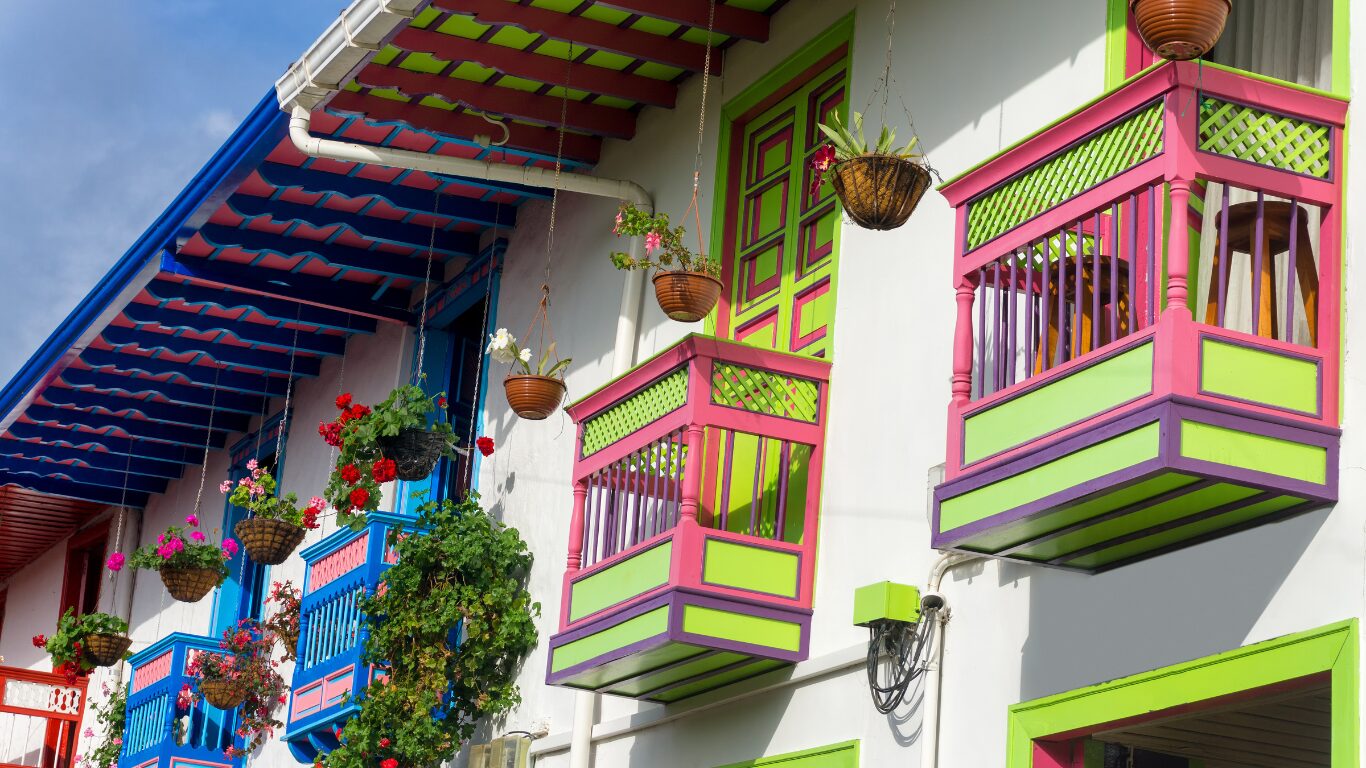
In the heart of Colombia’s Coffee Region, Salento stands out for its lush nature and coffee culture. This town is the perfect starting point to explore the Cocora Valley, home to the wax palm—the national tree of Colombia and one of the country’s most stunning natural wonders.
Places to Visit in Salento, Quindío
Salento, known as the “father of Quindío,” is not only the oldest municipality in this Colombian department but also a vibrant center of coffee and nature culture. It attracts visitors from all over the world with its rich history, breathtaking landscapes, and colonial architecture. Here are some must-visit places:
Cocora Valley: Famous for being home to the wax palm of Quindío, Colombia’s national tree. This valley offers spectacular landscapes, opportunities for hiking among towering palms, and the chance to spot a variety of bird species. It’s an excellent place to connect with nature and enjoy outdoor activities like hiking, horseback riding, and birdwatching.
Nature Reserves and Coffee Farms: Exploring a coffee farm is essential to understanding the coffee culture of the region. Salento offers tours where you can see the coffee production process up close—from harvest to cup. You can also enjoy the beauty of nature reserves like Kasaguadua, where biodiversity and conservation are present at every step.
Hikes and Outdoor Adventures: Salento is the starting point for various excursions and outdoor activities. You can go hiking in the Santa Rita Natural Reserve, take in the traditional Coffee Region landscapes, and swim in natural pools. For adventure lovers, there are options like rafting on the Río de la Vieja and paragliding in Buenavista, both offering unique experiences and spectacular views of the region.
Town Tour: Walking through the streets of Salento lets you admire its colonial architecture, especially the colorful balconies of its houses. You can also visit the lookout point for panoramic views of the town and its surroundings, enjoy local cuisine in its restaurants, and take part in traditional festivities held throughout the year.
Salento offers a unique blend of natural beauty, coffee tradition, and cultural heritage, making it a must-visit destination for any traveler in Colombia. Whether you’re interested in outdoor adventures, coffee culture, or simply relaxing in a stunning natural setting, Salento has something for everyone.
6. Salamina, Caldas: The City of Light of Caldas
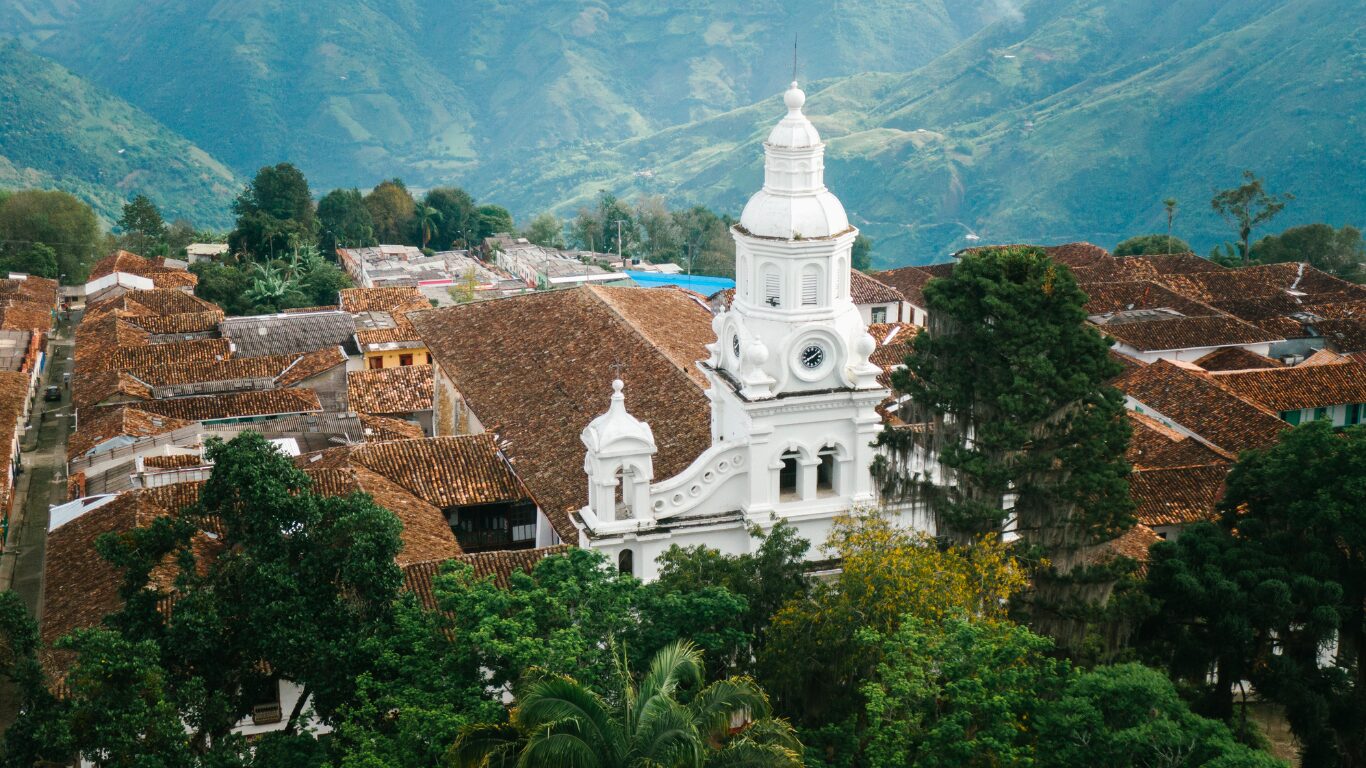
Salamina, one of Colombia’s most beautiful towns and affectionately known as the “City of Light” of Caldas, stands out for its stunning Republican architecture and its designation as a UNESCO World Heritage Site. This town is a living testament to Colombia’s coffee history, surrounded by breathtaking landscapes and home to a community that keeps regional traditions and culture alive.
Places to Visit in Salamina, Caldas
Salamina, known as the “City of Light” of Caldas, is a destination that captivates visitors with its rich cultural heritage and remarkable natural beauty. Here are some must-see places:
La Samaria Wax Palm Forest: This forest is home to the wax palm, Colombia’s national tree, and offers a natural spectacle of towering palms that have grown for over 60 years. It’s ideal for nature lovers and those interested in Colombia’s unique biodiversity.
Temple of the Immaculate Conception: A Romanesque-style architectural gem, this temple is famous for its stunning façade and lavish interior, including beautiful stained glass windows. Its bell, made from gold coins, jewelry, and precious metals donated by locals, symbolizes Salamina’s strong community spirit.
Historic Center of Salamina: Strolling through the historic center feels like stepping back in time, with its cobblestone streets and traditional architecture. The Rodrigo Jiménez Mejía Cultural House and the town’s central kiosk are highlights known for their beauty and historical value.
San Esteban Cemetery: This is not only a resting place but also a site full of history and art. Its gothic-style chapel, along with mausoleums and gardens, create a peaceful space for reflection.
Basilica of the Immaculate Conception: This impressive temple is one of the most important religious centers in Caldas, known for its Romanesque architecture and its central role in the region’s spiritual and cultural life.
Cultural Activities and Festivals: Salamina is famous for its vibrant festival calendar, including the “Fiestas del Aire” in December. These events showcase agricultural products, host guest artists, and feature cultural activities that reflect the town’s rich heritage.
In addition to these iconic places, Salamina offers a range of accommodations and outdoor activities such as natural pools, glamping, sport fishing, and more—ensuring a memorable experience for all visitors.
Each of these places adds to Salamina’s unique charm, making it an unmissable destination in Colombia’s Coffee Cultural Landscape. Its rich history, natural beauty, and the warmth of its people promise an unforgettable experience for every traveler.
7. Monguí, Boyacá: La Puerta al Páramo de Ocetá
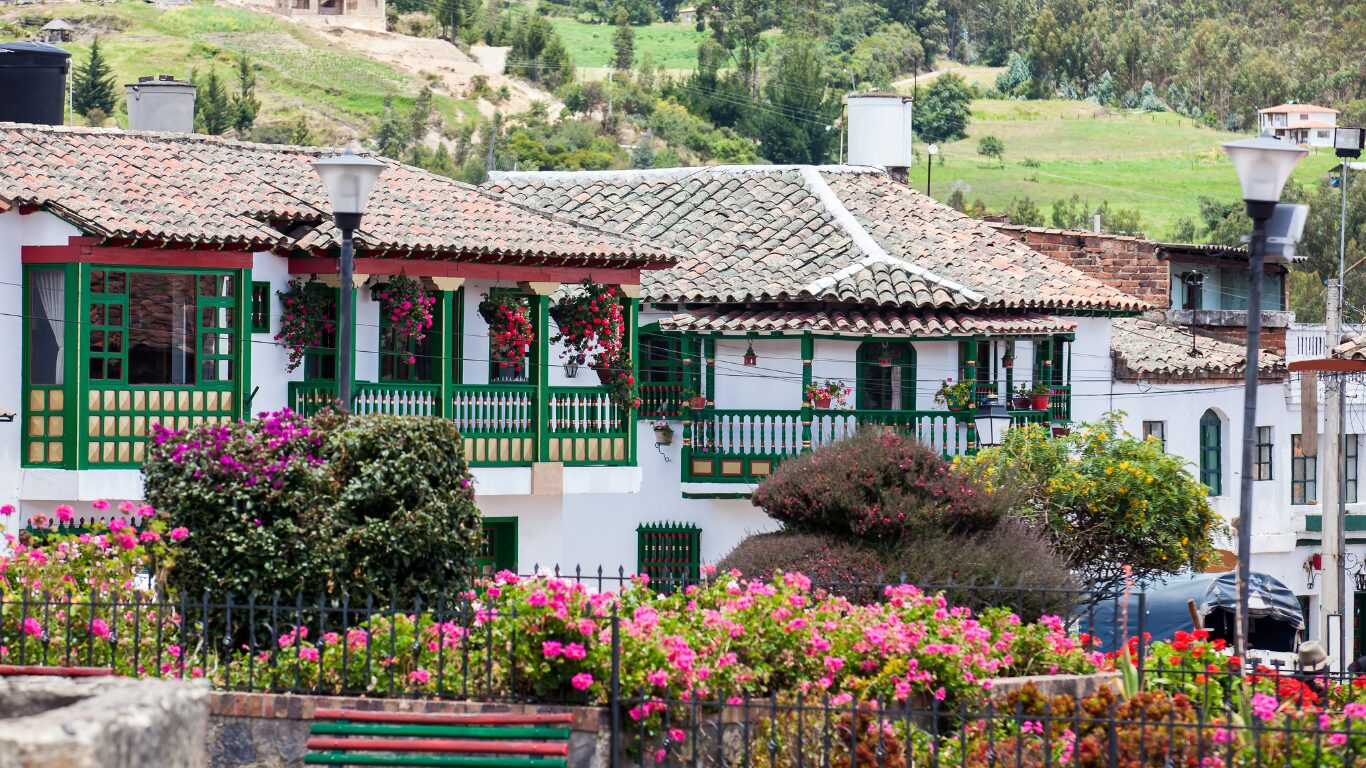
Monguí is a dreamlike town located in Boyacá, known for being the gateway to the Ocetá Páramo—one of the most beautiful páramos in the world. This municipality is not only remarkable for its natural beauty but also for its well-preserved colonial architecture and its historical significance as Colombia’s leading center for handmade soccer ball production.
Places to Visit in Monguí, Boyac
Monguí, known as the Most Beautiful Town in Boyacá, offers a perfect blend of natural beauty and cultural richness. This charming destination invites visitors to immerse themselves in an unforgettable experience, from exploring traditional ball factories to hiking through the stunning landscapes of the Ocetá Páramo.
National Monuments and Architectural Heritage: Don’t miss the Basilica and Cloister of Our Lady of Monguí, the Franciscan Convent, the Chapel of Saint Anthony of Padua, and the iconic Royal Bridge of Calicanto. These architectural gems, declared national monuments, reflect the rich history and cultural legacy of Monguí.
Artisanal Traditions: Monguí is famous for its handmade soccer ball industry, which has been the backbone of the local economy for over 80 years. Visiting one of the 20 ball factories allows you to see the craft up close—and maybe even take home a unique souvenir from your trip.
Nature and Adventure: The Ocetá Páramo, considered the most beautiful páramo in the world, is a must-see for nature lovers. Its trails lead you through páramo and subpáramo ecosystems, home to rich biodiversity and breathtaking scenery. Be sure to visit the mystical Laguna Negra, surrounded by frailejones—ideal for hiking enthusiasts and nature explorers.
Local Cuisine: No visit to Monguí is complete without tasting its delicious local dishes, such as Cocido Boyacense, a hearty stew perfect for chilly days, and Rainbow Trout, a regional favorite. These traditional flavors reflect Boyacá’s culinary heritage and will leave you wanting more.
Each of these places and experiences makes Monguí an exceptional tourist destination, where history, culture, nature, and gastronomy come together to offer visitors a truly memorable stay.
8.Mompox, Bolívar: The Island Where Time Stands Still
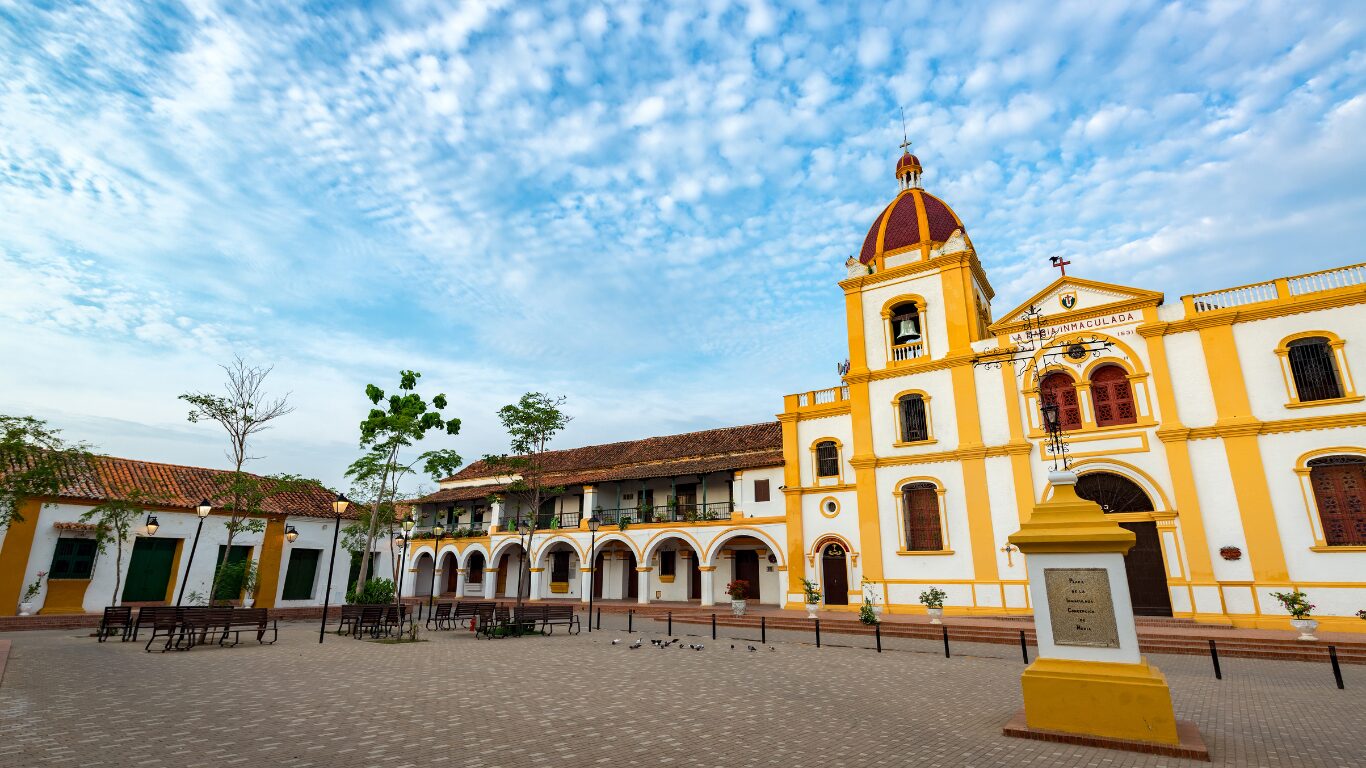
Mompox stands out for its significant role in Colombia’s history, especially during the fight for independence. This town seems frozen in time, with its intact colonial architecture reflecting the wealth and strategic importance of what was once a major river port.
Places to Visit in Mompox
Mompox, also known as Santa Cruz de Mompox, is a colonial gem located in Colombia’s Caribbean region. This heritage town is famous for its well-preserved colonial architecture, rich history, and cultural traditions. Here’s a selection of the most recommended places and activities to explore in Mompox:
Historic Center: Strolling along the cobblestone streets of the historic center is a must. The colonial architecture, grand houses with rocking chairs on their porches, and ornate wrought-iron window grilles are simply charming. Mompox invites you to lose yourself in its plazas and alleys, letting time slow down as you take in its beauty.
Mompox Churches: The town features several churches that stand out for their architecture and historical significance, such as the Church of Santa Bárbara, the Church of the Immaculate Conception, Santo Domingo, the San Francisco Convent, the Minor Basilica of the Holy Christ of Mompox, and the Church and Hospital of San Juan de Dios.
La Albarrada: A riverside promenade offering stunning views of the Magdalena River, perfect for experiencing how the town lives in harmony with the river. La Albarrada is full of stories and legends, and it’s a fantastic spot to watch the sunrise or sunset.
Ciénaga de Pijiño: Ideal for nature lovers, this wetland area offers opportunities for birdwatching and enjoying unique landscapes. On a boat tour, you can learn about traditional fishing techniques and even take a refreshing swim.
Local Cuisine and Momposina Filigree: You can’t leave Mompox without tasting its rich local cuisine or visiting a filigree workshop, where delicate jewelry is made using fine gold and silver threads. This internationally recognized artisanal tradition showcases the cultural wealth of Mompox.
Cultural Events: Mompox is also home to major cultural events such as Holy Week, famous for its processions and religious ceremonies that attract visitors from across the country, and the International Jazz Festival, which fills the town’s nights with music.
Mompox Cemetery: Known for its beauty and cultural importance, this cemetery is considered one of the most beautiful in Colombia. It offers a unique look at Mompox’s history and culture, especially during Holy Wednesday.
Handicrafts and Museums: The House of Culture, the Cultural Museum of Religious Art, and various local workshops—especially those dedicated to filigree—are must-visit spots to better understand the cultural and artistic richness of Mompox.
These are just a few of the experiences you can enjoy in Mompox—a place where time seems to have stopped, and every corner tells a story.
9. La Playa de Belén, Norte de Santander: A Picturesque Landscape
Lugares para Visitar en Playa de Belén
In the department of Norte de Santander, La Playa de Belén stands out for its unique rock formations and a historic town center that evokes a bygone era. This small municipality is a hidden gem that offers tourists a peaceful experience and an opportunity to connect with nature.
Places to Visit in La Playa de Belén
La Playa de Belén, in Norte de Santander, is a destination rich in natural landscapes, colonial architecture, and unique cultural experiences. Here are some recommended places and activities to enjoy:
Los Pinos Viewpoint: A reforested pine viewpoint that offers stunning panoramic views, perfect for photography sessions or simply for enjoying a quiet moment of reflection.
San José Church: Completed in 1948, this modest church may not be as grand as others in the region, but it holds great value for the local community and serves as the center for important religious celebrations.
Yaraguá Natural Park: A private area offering activities such as camping, paintball, and canopy, with spectacular views of the surrounding areas—including the town and the Estoraques rock formations.
Los Estoraques National Natural Park: Known for its unique rock formations sculpted by water and wind erosion, walking through this park feels like entering a natural labyrinth. It is home to rich biodiversity, including various bird and mammal species.
Canopy and Other Outdoor Activities: Near the town center, there’s a private recreational park that offers adventure activities like canopy tours between the hills, providing impressive views of Los Estoraques and the surrounding landscape.
Cultural Exploration and Festivals: La Playa de Belén offers rich cultural experiences, especially during Christmas, with interactive nativity scenes, traditional novenas, and festive masses involving the entire community.
To reach La Playa de Belén, it’s recommended to travel by road from Cúcuta, passing through several towns along the way. The village is characterized by its cobblestone streets and whitewashed houses with red accents and charming balconies.
During your visit, be sure to try local sweets and typical products such as brevas con arequipe (figs with caramel) and cebollitas ocañeras, adding a delightful gastronomic touch to your trip.
La Playa de Belén is a fascinating place that combines natural beauty with cultural richness and stands as a testament to Colombia’s heritage and history.
10. Zipaquirá, Cundinamarca: The Salt Cathedral
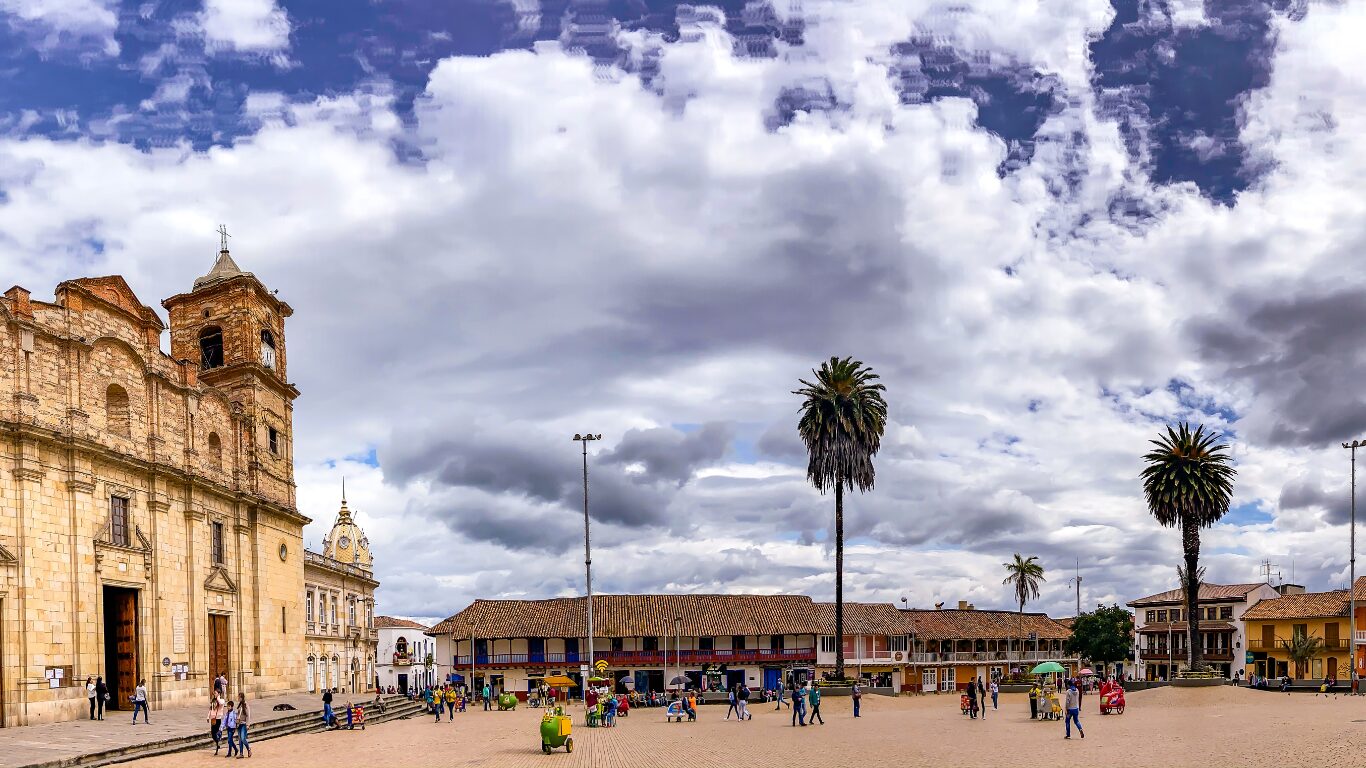
Zipaquirá is famous for being home to one of Colombia’s architectural wonders: the Salt Cathedral. Built within the salt mines, this impressive site is not only a place of religious pilgrimage but also a unique architectural landmark in the world.
Places to Visit in Zipaquirá
Zipaquirá is known not only for its wealth of salt but also for its historical and cultural importance in Colombia. This destination offers a complete experience for both national and international visitors, with its most iconic attraction—the Salt Cathedral—standing as a spiritual and architectural achievement. Its proximity to Bogotá also makes it an easily accessible city filled with history, culture, and nature.
Salt Cathedral: Zipaquirá’s main attraction, this architectural marvel carved inside a salt mine, offers a fascinating tour through its underground chambers, where art, faith, and geology come together in a truly unique way. The surrounding park also features museums and various activities for all visitors.
Salt Park (Parque de la Sal): Beyond the Cathedral, the park includes additional attractions like the Brine Museum (Museo de la Salmuera) and the Archaeological Museum, with various tour options and prices tailored to different experiences.
Plaza de los Comuneros & Plaza de la Independencia: These squares are at the heart of Zipaquirá’s civic and cultural life. The Plaza de los Comuneros, in particular, is flanked by significant historical buildings and serves as a vibrant meeting place for visitors.
Ecoparque Nukasa & Tatacoita Desert: For nature lovers and outdoor adventurers, Zipaquirá offers options like the Nukasa Ecopark and the Tatacoita Desert, where you can enjoy hiking and exploring unique natural landscapes.
Zipaquirá Train Station: A national monument and historical reminder of the role of trains in Colombia. It offers a different perspective on transportation and the country’s development.
Additionally, Zipaquirá invites visitors to explore its rich culinary and lodging offerings, catering to a wide range of preferences. The city is a living testament to Colombian history—from pre-Columbian times to the present—offering a unique cultural journey complemented by its growth as a commercial and economic center thanks to its salt production.
Each of these places adds to the unique experience Zipaquirá offers, combining history, culture, and natural beauty in a way few cities can match.
11. Leticia, Amazonas: Gateway to the Amazon
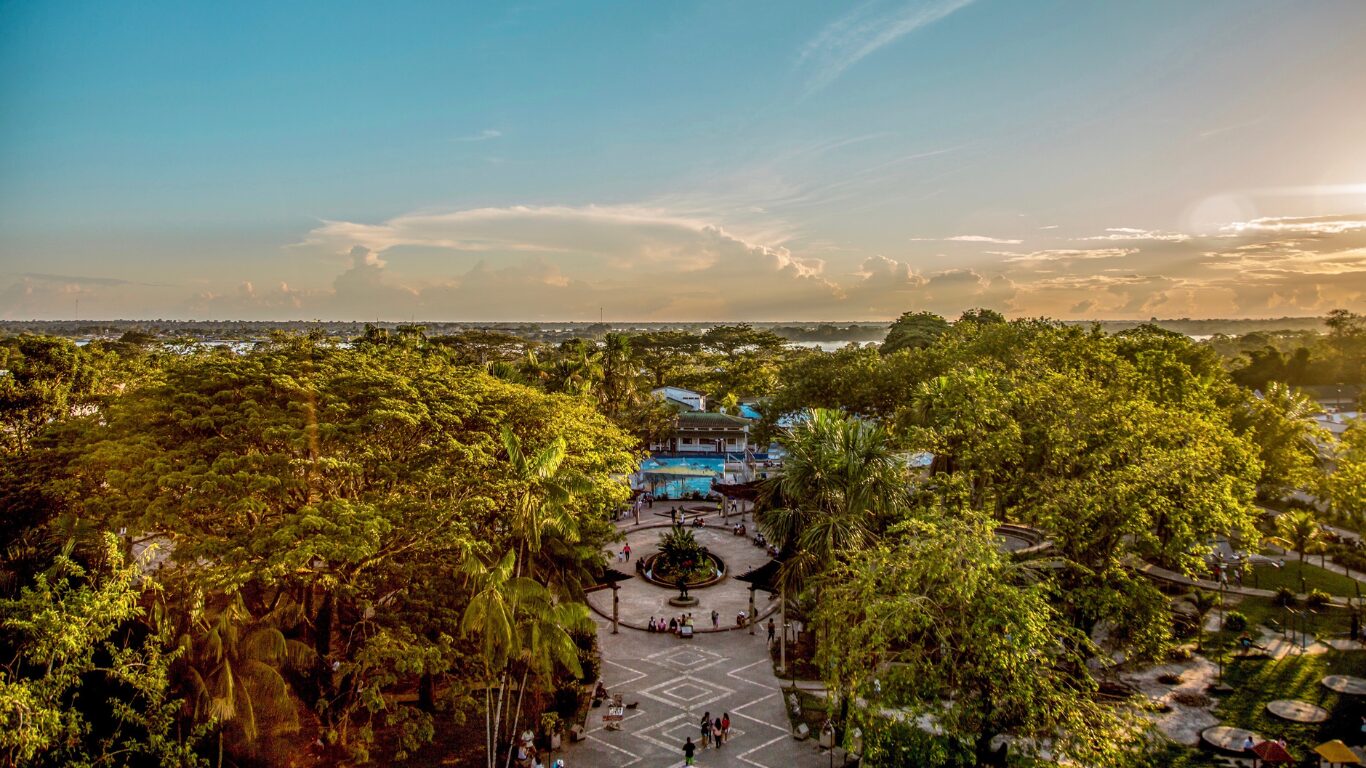
Located in the department of Amazonas, Leticia serves as the gateway to the Amazon rainforest—one of the most biodiverse regions on the planet. This town offers a unique opportunity to connect with nature and discover the indigenous cultures of the Amazon.
Places to Visit in Leticia, Amazonas
Leticia, the gateway to Colombia’s Amazon, offers a fascinating mix of natural, cultural, and gastronomic adventures. From boat tours along the majestic Amazon River to exploring nature reserves and engaging with indigenous communities, every activity in Leticia promises to be unforgettable.
Amazon River Tour: The essence of visiting Leticia lies in exploring the Amazon. Tour operators offer various excursions that include visits to indigenous communities, pink dolphin watching, jungle treks, and piranha fishing.
Tanimboca Natural Reserve: Just outside Leticia, this reserve allows you to get up close with native wildlife and take part in activities like zip-lining, hiking, and kayaking. It also offers treehouse lodging for an immersive jungle experience.
Mundo Amazónico Ecological Park: This educational park near Leticia is perfect for learning about the region’s ecology, native tribes, and Amazonian culture. You can explore it on your own or join guided activities.
Tourist Boardwalk: A relaxing walk along the boardwalk offers views of the Amazon River and a glimpse into local life, including fishing boats and river trade.
Monkey Island (Isla de los Micos): A squirrel monkey sanctuary where visitors can interact closely with the animals, while also browsing and purchasing local indigenous crafts.
Santander Park: Especially vibrant at dusk, this park becomes a spectacle of sound and color as flocks of parrots and parakeets gather in the trees.
Lake Tarapoto: Famous for being one of the best spots to see pink dolphins, this lake is surrounded by indigenous legends and offers a unique experience of Amazonian biodiversity.
Macedonia Community: Visiting this community on the banks of the Amazon River offers the chance to meet the Tikuna people and admire their artisan craftsmanship.
Puerto Nariño: This peaceful, car-free town is known for its colorful houses and offers a quiet environment to enjoy nature and indigenous culture.
Tabatinga, Brazil: Just across the nearly invisible border from Leticia, you can experience Brazilian culture, try its cuisine, and visit local attractions.
Each of these places and activities in and around Leticia lets you experience the richness of the Amazon—from its biodiversity to its cultural depth. It’s a destination with something for every kind of traveler, ensuring an unforgettable journey into the heart of the rainforest.
12.Filandia, Quindío: A Gem of the Coffee Cultural Landscape
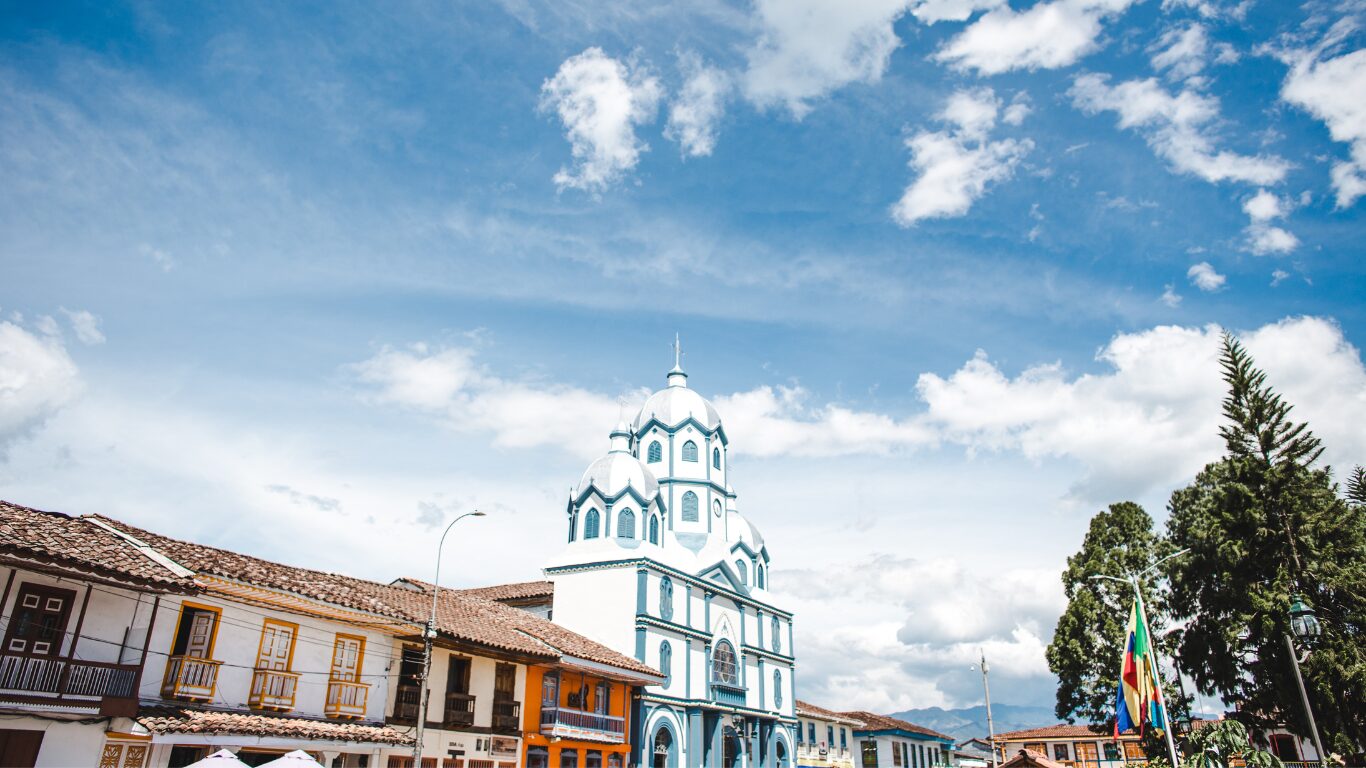
Filandia stands out for its vibrant community life, colorful architecture, and privileged location in the heart of Colombia’s Coffee Region. This town is not only a testament to the country’s rich coffee culture, but also a shining example of heritage preservation and appreciation.
Places to Visit in Filandia, Quindío
Filandia is a charming town in Quindío, Colombia, known for its deep-rooted coffee traditions, stunning landscapes, and colorful buildings. Here’s a list of must-see places and activities you shouldn’t miss:
Mirador del Tiempo Detenido: Perfect for enjoying the sunset and taking in the calm surroundings. It’s located near the town center and offers breathtaking views.
Mirador Encanto: Inspired by Disney’s movie Encanto, this spot is great for fun and creative photos. Entry is affordable and it’s a hit with families and visitors of all ages.
Visit to Coffee Farms: Don’t miss the chance to learn about the coffee-making process—a central element of the region’s culture.
Café Quindío: Treat yourself to a high-quality cup of Colombian coffee at this cozy café, and consider taking home some freshly roasted beans as a souvenir.
Colina Iluminada Viewpoint: A stunning lookout point where you can admire Filandia’s natural surroundings in all their glory.
Barbas Bremen Canyon: This natural reserve is an ecotourism paradise, perfect for spotting howler monkeys and more than 200 bird species.
Basketry Interpretation Center: Located near the central park, this spot showcases local craftsmanship using natural fibers—part of Filandia’s unique cultural heritage.
Photographic Archive: Travel through the town’s history via photos exhibited at the Casa del Artesano (Artisan’s House).
Bremen – La Popa Nature Reserve: A magical spot for nature lovers, offering interpretive trails rich in native flora and fauna.
Church of María Inmaculada: Overlooking the town’s main square, this historic church dates back to the early 20th century and adds to the town’s colonial charm.
Filandia offers a wide range of accommodations, from cozy hostels to coffee farm stays, catering to all budgets. This picturesque town welcomes all types of travelers, with activities ranging from eco-tourism to cultural exploration—plus a delicious array of local cuisine.
13. San Agustín, Huila: The Pre-Columbian Mystery

San Agustín is world-renowned for its archaeological park, home to the largest collection of religious monuments and megaliths in South America. This site is not only a UNESCO World Heritage Site for its historical and archaeological significance but also a meeting point between nature and the ancient civilization that once inhabited the region.
Places to Visit in San Agustín, Huila
San Agustín, Huila, is a fascinating destination full of mystery and natural beauty, mainly known for its archaeological and cultural value. Here, pre-Columbian history and majestic landscapes intertwine to offer a truly unique experience.
San Agustín Archaeological Park: The cultural heart of the region, declared a UNESCO World Heritage Site. This park holds the largest collection of megalithic sculptures in South America, reflecting the beliefs and worldview of the Agustinian culture. The visit also includes the Forest of Statues, where 35 stone sculptures are displayed in a lush natural setting.
Obando Museum: Located within the archaeological complex, this museum exhibits tombs, pottery, and carved stone artifacts. It offers deep insight into the burial practices and daily life of the ancient cultures that lived in the area.
Luis Duque Gómez House Museum: Honoring the renowned Colombian archaeologist, this museum presents a broad collection of Agustinian archaeological objects. It is located within the main park and is essential for those who wish to deepen their knowledge of the region.
Alto de los Ídolos and Alto de las Piedras Archaeological Parks: Though less known, these parks complement the main site and offer a different perspective on the area’s archaeological wealth. Alto de los Ídolos can be accessed using the same ticket as the main park.
Other Ceremonial and Archaeological Sites: The surroundings of San Agustín are dotted with interesting sites such as El Tablón, La Chaquira, La Parada, Quebradillas, Alto de Las Chinas, La Pelota, and El Purutal. These places provide a broader view of the spiritual and ceremonial significance of the region to pre-Columbian cultures.
For a full experience, it’s recommended to stay at least two days in the area—one day for the main archaeological park, and another to explore the surrounding sites and natural wonders. Guided excursions are available, often requiring 4×4 vehicles or horseback to reach the more remote locations.
Lodging and Cuisine: San Agustín offers a variety of accommodations to suit all budgets, from budget hostels to more luxurious hotels. You’ll also find excellent restaurants serving delicious local cuisine.
Visiting San Agustín means stepping into a world where past and present coexist in a landscape of unmatched beauty. It’s a destination that not only educates about the rich legacy of pre-Columbian cultures but also inspires through its scenery and the warmth of its people.
14. San Gil, Santander: The Adventure Capital
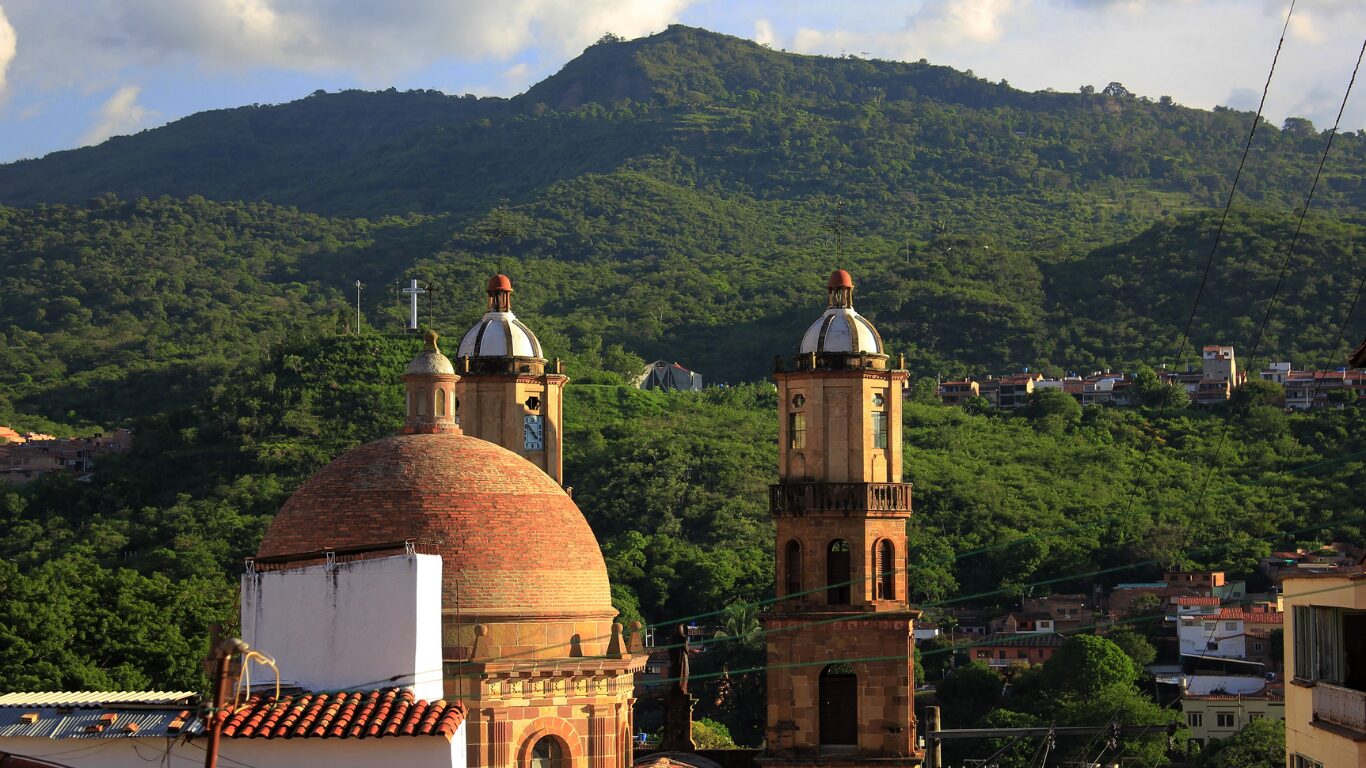
San Gil has earned the title of “The Adventure Capital” of Colombia, thanks to its privileged location that makes it the perfect starting point for a wide range of extreme sports and outdoor activities. Located in the department of Santander, this town is not only a paradise for adrenaline lovers but also a place with rich cultural heritage.
Places to Visit in San Gil, Santander
Known as the Pearl of the Fonce and the Tourism Capital of Santander, San Gil is an unbeatable destination for adventure seekers, nature lovers, and those looking for romantic getaways. It offers a vibrant mix of outdoor experiences, delicious gastronomy, and natural wonders that you just can’t miss.
Juan Curi Waterfall: This spectacular natural site is ideal for nature lovers and thrill-seekers alike, especially for those wanting to try rappelling. Located just a few kilometers from San Gil, it’s a must-visit spot for enjoying stunning scenery.
El Gallineral Park: Famous for its unique vegetation and the white moss (Spanish moss) that drapes its trees, this park offers a peaceful and refreshing environment. Visitors can enjoy rafting or relax at La Playita de la Piedra del Pato, a popular area for water-based fun.
Pozo Azul: This natural pool is renowned for its crystal-clear blue waters and accessible caves, making it a perfect location for both relaxation and adventure.
Extreme Sports: San Gil is Colombia’s premier destination for adventure tourism. You can go paragliding over the breathtaking Chicamocha Canyon, or experience rafting on the Fonce and Suárez rivers. Other exciting activities include zip-lining, bungee jumping, and mountain biking—perfect for adrenaline junkies.
Local Cuisine: You can’t leave San Gil without trying the famous hormiga culona (big-bottomed ant), a regional delicacy, along with other local favorites like Mute (a traditional soup) and Cabrito Santandereano (roasted young goat). The town’s marketplace is the best place to explore these culinary treasures.
Culture and Tradition: San Gil also invites you to immerse yourself in its vibrant culture and traditions through festivals like Guane de Oro, the Festival de Carrancios, and other fairs that showcase the best of local music, food, and customs.
Lodging: San Gil offers a wide range of accommodations, from hotels and hostels to camping areas, fitting all budgets and preferences. The warmth and hospitality of its people will make you feel at home as you explore this dynamic and adventure-filled destination.
With such a rich offering of activities and sites to explore, San Gil stands out as a must-visit destination for anyone looking for adventure, culture, and natural beauty in the heart of Colombia.
Conclusión
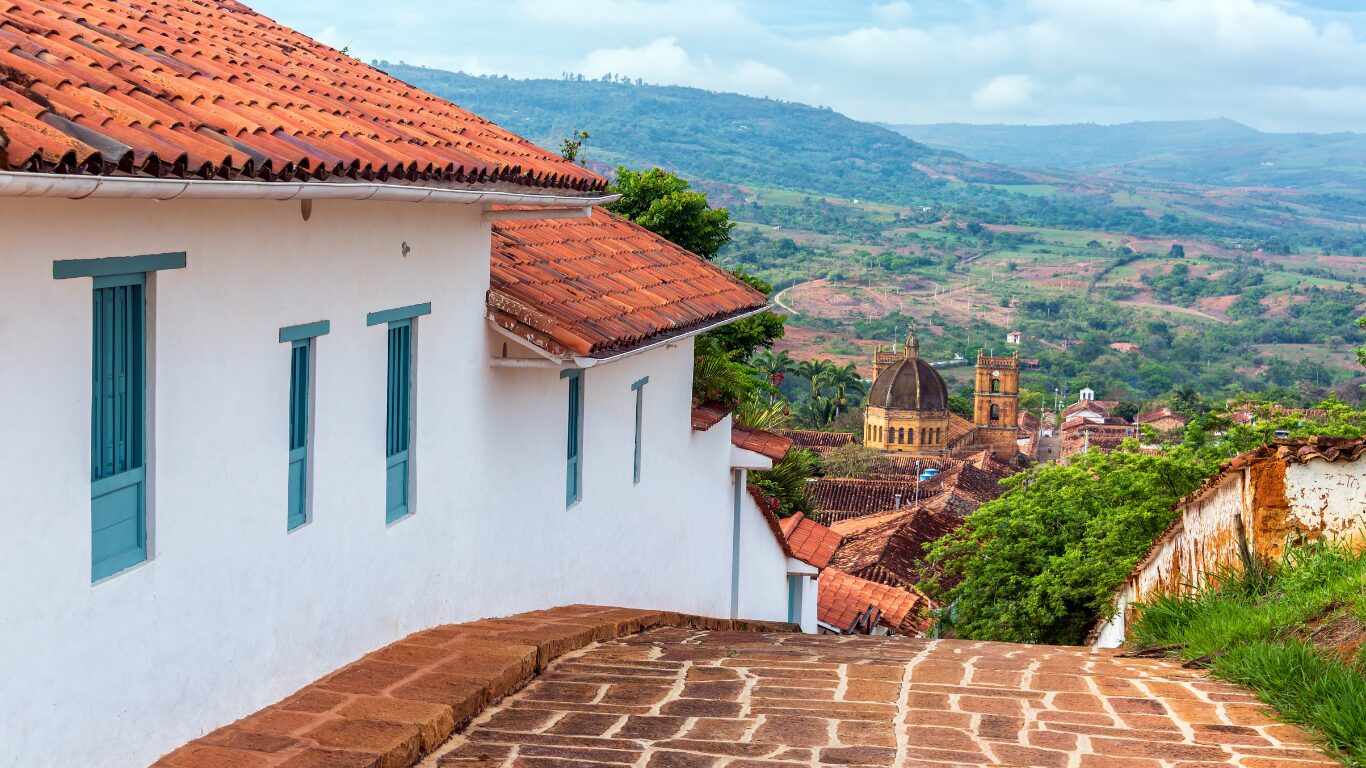
Exploring the towns of Colombia takes us on a journey that weaves together the country’s cultural, historical, and natural richness, revealing the soul of a nation expressed through its cobblestone streets, vibrant squares, and the warmth of its people.
Each place we visit tells a unique story—one woven through generations and now presented to us as an invitation to discover the most beautiful towns in Colombia: those hidden gems that stand out not only for their beauty but also for their authenticity and welcoming spirit.

When speaking of these destinations, we cannot overlook the importance of the Red de Pueblos Patrimonio de Colombia (Network of Heritage Towns of Colombia), an initiative aimed at preserving and promoting those towns that represent the country’s cultural and natural heritage.
This network stands as a testament to Colombia’s commitment to conserving its history and fostering sustainable, responsible tourism—inviting both locals and visitors from around the world to immerse themselves in the heart of Colombia.
For travelers, each town offers the chance to create unforgettable memories—whether alone, with friends, or as a couple. These are places that invite reflection and enjoyment, while also offering countless activities suited to all tastes and needs. From the thrill of extreme sports in San Gil to the peaceful charm of a sunset in Villa de Leyva, each destination has something truly unique to offer.
4o
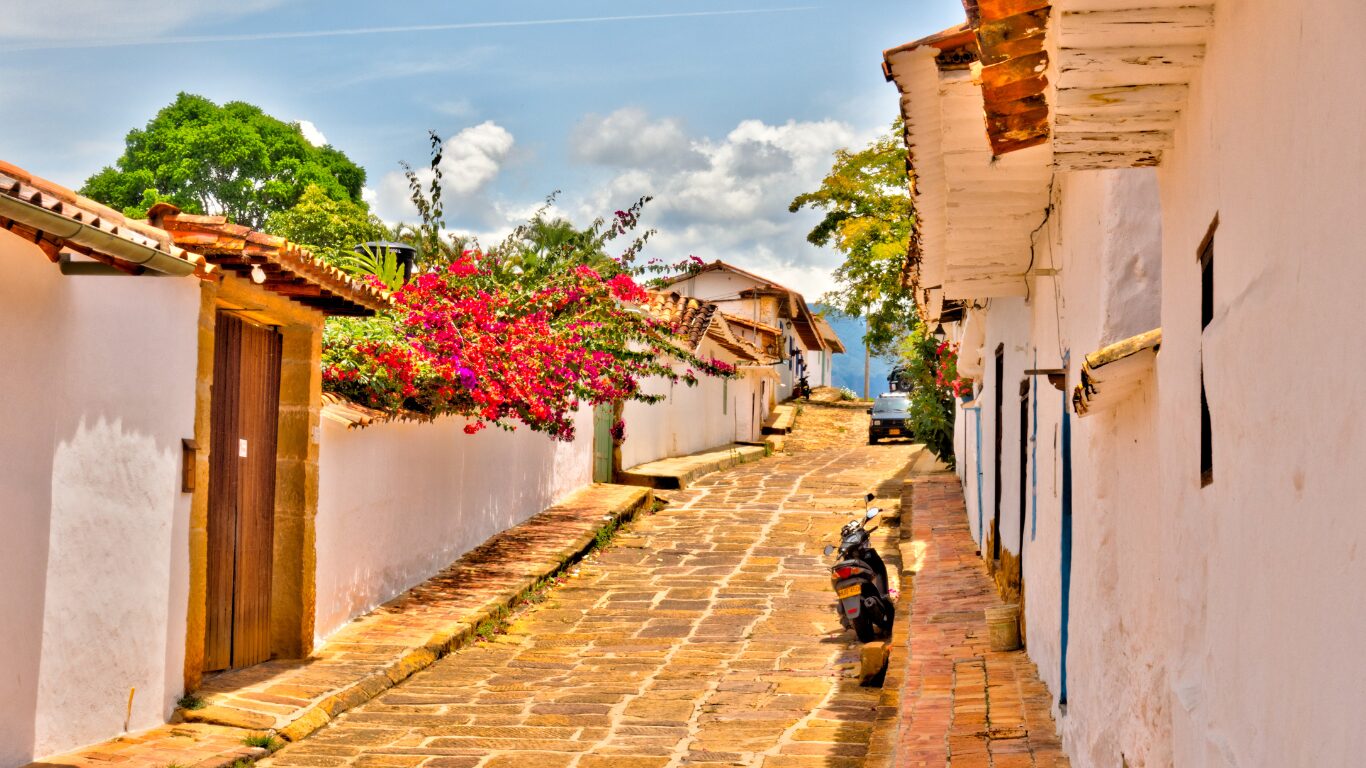
When speaking of these destinations, we cannot overlook the importance of the Red de Pueblos Patrimonio de Colombia (Network of Heritage Towns of Colombia), an initiative aimed at preserving and promoting those towns that represent the country’s cultural and natural heritage.
This network stands as a testament to Colombia’s commitment to conserving its history and fostering sustainable, responsible tourism—inviting both locals and visitors from around the world to immerse themselves in the heart of Colombia.
For travelers, each town offers the chance to create unforgettable memories—whether alone, with friends, or as a couple. These are places that invite reflection and enjoyment, while also offering countless activities suited to all tastes and needs. From the thrill of extreme sports in San Gil to the peaceful charm of a sunset in Villa de Leyva, each destination has something truly unique to offer.

En conclusión, los pueblos de Colombia ofrecen una paleta de experiencias que van desde el asombro ante la majestuosidad de sus paisajes hasta el encuentro profundo con sus tradiciones y su gente. Son lugares que encierran historias de resistencia, de encuentros culturales y de una belleza natural que cautiva.
Visitar estos pueblos no es solo hacer turismo; es sumergirse en la historia viva de Colombia, es participar de una trama que se sigue escribiendo día a día y que invita a todos a ser parte de ella. Este artículo es un homenaje a esos rincones de Colombia que, con su encanto y riqueza, nos recuerdan la importancia de explorar, conocer y proteger nuestro mundo.

